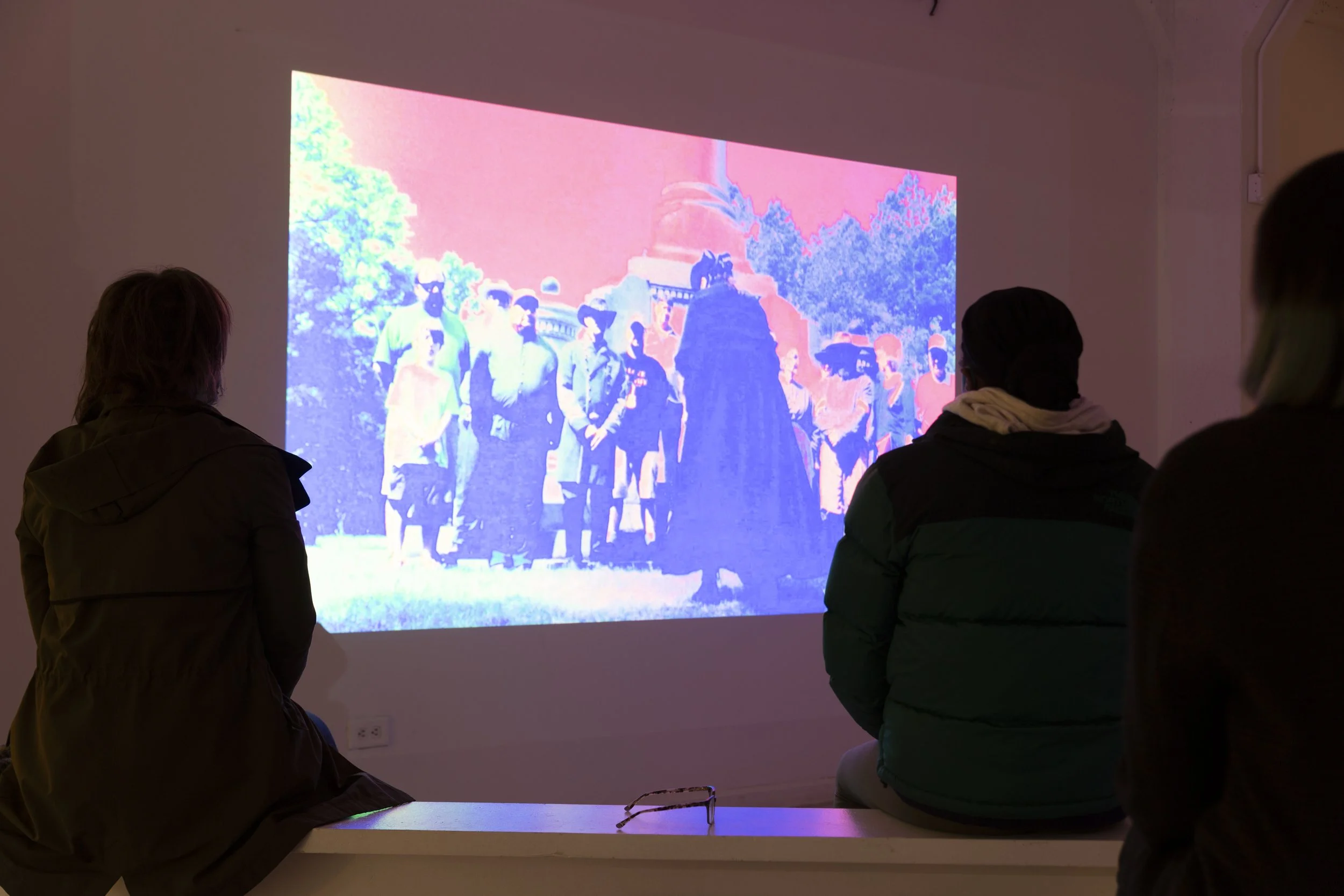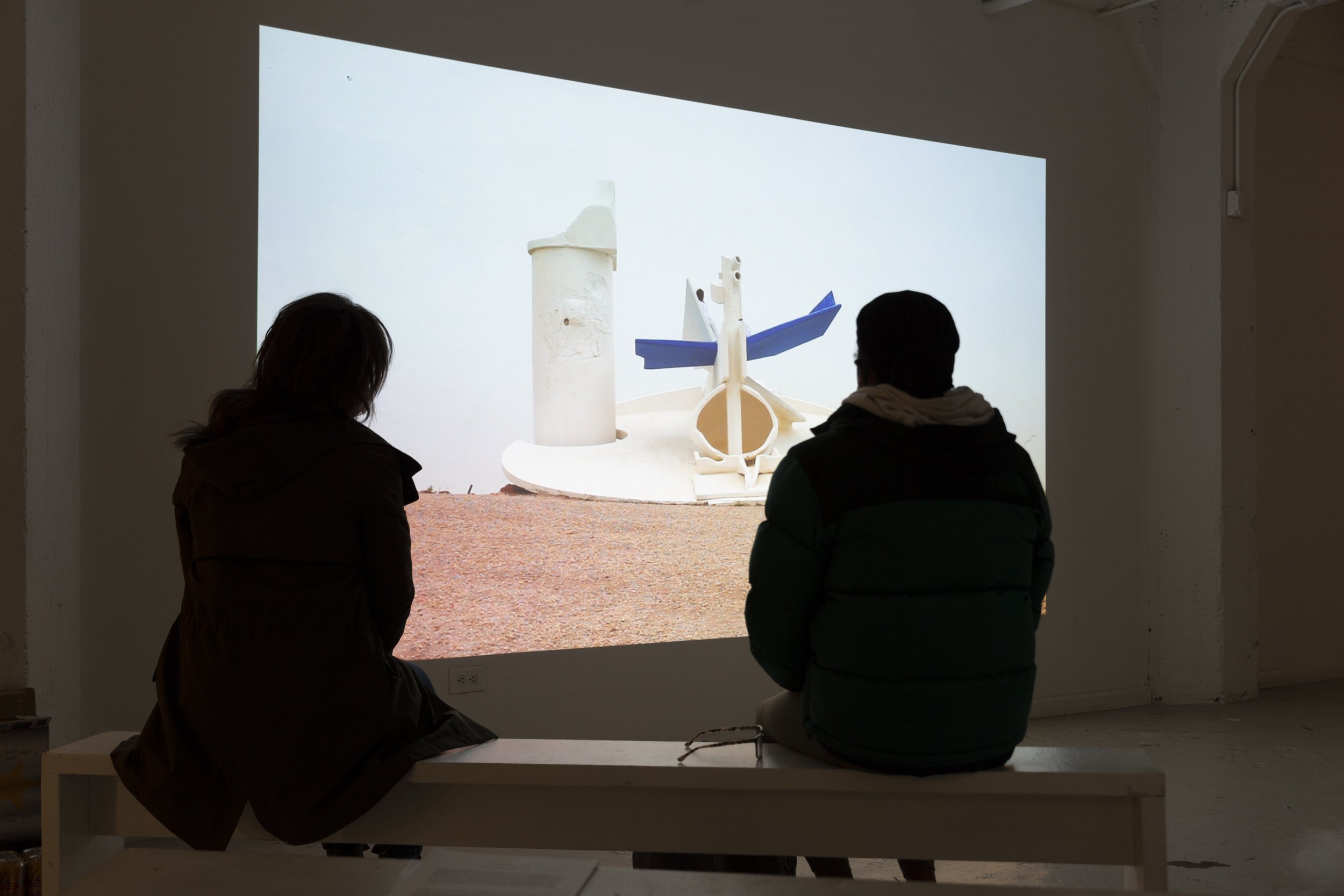Unmaking Monuments
Curated by Nicky Ni
November 7th, 2021
In accordance with Kelly Kirsten Jones's forthcoming project, Plinths for the People, this screening program glimpses at the auras and complexities around what we broadly consider as the monuments: from Nazi architectures, confederate monuments, to landmark buildings with a scandalous past. Some are structures erected to commemorate or to serve historic moments; others are significant public projects that, upon completion, involuntarily become constant reminders of their own being and their permanent space-making. As humans, we personify the stones and the bronze, which have a material existence much longer than our lives. We consider these materials a witness to our histories, complicit in our violence, a substitute for our memories, a signifier of our oblivion. Knowing full well the powerlessness of individual vis-a-vis public projects that take generations to uphold, the artists behind these works deploy various artistic tactics to highlight the brutality of the monuments, to question and to cope with their presence, and to ponder on the possibility of unmaking them.
Alexander Kluge & Peter Schamoni (DE), Brutality in Stone, 1961. Digital format, b&w, sound, 10:42 mins.
In his experimental short film Brutalitaet in Stein (Brutality in Stone), Alexander Kluge demonstrates how Nazi architecture used dimensions of inhuman and super-human scale to bolster the regime's politics of the same kind. Shots of huge neo-classical architectural structures from the Nazi period are confronted with equally anti-human national-socialist language as a voice-over. (UbuWeb)
Sabine Gruffat (US), Take It Down, 2019. Digital format, color, sound, 12:37 mins.
This film looks to North Carolina to describe the cultural fissure that runs through the South, a legacy of the Civil War. In the context of the divisive Trump presidency and the increasing visibility of white supremacist activism, these Confederate memorials have become sites of conflicting politics and historical narratives. (Video Data Bank)
Alona Weiss (IL/US), Kiss A Statue, 2016. Digital format, color, sound, 5:00 mins.
A neglected Brutalist public monument is repurposed as a platform for an Acro-Yoga session. The gymnastic practice requires a power balance based on contact, communication, and trust. As the acrobats blend with the geometrical shapes and outlines of the monument, a triangular relationship is formed: a relationship between the couple and their intimate strive to balance their bodies, and between the surface of the structure, that dictates and challenges their movements with its crooked angled surfaces. The sculpture was built in l968 at the outskirts of
Arad in Israel, by sculptor Yigal Tumarkin, an artist best known for building war monuments and large-scale public artworks around Israel. (Courtesy of the artist)
Julia Meltzer, David Thorne. Take into the air my quiet breath, 2007. Digital format, color, sound, 16:22 mins.
In 1966, the Syrian government's Ministry of Endowments solicited plans for a building to replace a 14th-century Mamluk mosque in Martyr's Square in the center of Damascus. A young architect proposed a design for a 5-star hotel and new mosque. In 1971, his plans were scrapped. In 1982, a building began to be built. Hospital? Parking garage? Military housing? The project--now called the Basel al-Asad Center--has been the subject of much rumor and speculation. As of 2007, the building remains unfinished. In this documentary video, an architect recounts the chronicle of the building and considers its possible future. (Video Data Bank)
Yuan Zheng (CN), A Failed Flight: Jiuquan Airport, 2018. Digital format, color, silent, 13:04 mins.
In 1983, Korean Air Lines Flight 007 (also known as KAL 007), a flight with 200-odd passengers that deviated from its original route from New York to Seoul and flew into Soviet territory, was shot down by Soviet fighter jets. In the wake of the accident, the US government decided to expand the Global Positioning System (GPS) from exclusive military use to civilian purposes. A Failed Flight: Jiuquan Airport recorded how a drone took off and crashed in the former Jiuquan Airport of China-Soviet Civilian Airlines (CSCA) due to the loss of GPS signals. CSCA, announcing that it would open a business in 1950, was China’s first joint venture before China's economic reform and opening-up. Then in 1954 when Nikita Sergeyevich Khrushchev, then the first Secretary of the Communist Party of the Soviet Union (1953–1964) paid a visit to China, CSCA was transformed into a wholly-owned company in China, and finally became a historical bygone as China and the Soviet Union fell afoul of each other at the end of the 1950s. However, its relics from its time as CSCA Jiuquan Airport, one of the earliest airports to be put into use in Northwest China, has now become the first airport-oriented Major Historical and Cultural Site Protected at the Municipal Level in the country. (Courtesy of the artist)
Bios
Alexander Kluge is a German filmmaker, producer, philosopher and writer. He has produced a remarkable series of works for television. Traversing realms of desire and culture in the 19th and 20th centuries, these experimental works weave together eclectic references — advertising, cinema, opera, communications — to construct an ironic critical discourse on fantasy, representation, and history. Peter Schamoni was a German film director, producer and screenwriter. He was a signatory of the 1962 Oberhausen Manifesto. Films that he directed include: No Shooting Time for Foxes (1966), Spring Symphony (1983), and Niki De Saint Phalle: Who Is the Monster, You or Me? (1995). (Electronic Arts Intermix)
Alona Weiss is a multidisciplinary artist and filmmaker working with video and mixed media. She received her MFA from Parsons, The New School, NY, and BDES from Bezalel Academy of Art and Design, in Jerusalem. Her screenings, exhibitions, and public lectures include: Lesley Heller Workspace (New York); The Haifa Museum of Art (Israel); Lincoln Center (New York); The Beijing Film Triennial (China); Arad Contemporary Art Center (Israel); El Museo de Los Sures, (Brooklyn); The Kitchen (New York); Genia Schreiber Gallery (Tel Aviv); Columbia University School of The Arts (New York); Local Projects (Queens), and Fikra Biennial, (United Arab Emirates). She has been awarded the Hearst Scholarship, The AICF Sharet-Fund, The Oscar Collin Fellowship, Parsons Graduate Award, Graduate Dean’s Scholarship, and The New School Merit Scholarships. (Courtesy of the artist)
Julia Meltzer is a media artist and executive director of Clockshop, a non-profit production company based in Los Angeles. Her works are realized in video, installation, and performance presentations. Her work has been exhibited and broadcast at venues including Creative Time's Art in the Anchorage, The New Museum of Contemporary Art (New York), Mass MOCA (West Adams, Massachusetts), Forum Stadtpark (Graz, Austria), the Dutch Electronic Arts Festival (Rotterdam, the Netherlands) and on selected PBS television stations. She has taught video and digital media at Hampshire College and UC Irvine. David Thorne lives and works in Los Angeles. His recent work addresses the conditions of so-called globalization; notions of justice shot through with revenge; and memory practices in a moment of excessive rememorations. Current projects include The Speculative Archive (with Julia Meltzer); the ongoing series of photo-works, Men in the News (1991-present); and the URL project Boom! with Oliver Ressler. (Video Data Bank)
Sabine Gruffat is a French-American artist who works with experimental video and animation, media-enhanced performance, participatory public art, and immersive installation. She is also a filmmaker with a special interest in the social and political implications of media and technology. Her experimental and essay films explore how technology, globalization, urbanism, and capitalism affect human beings and the environment. These films seek to empower people, encourage social participation, and inspire political engagement. Sabine's films and videos have screened at festivals worldwide including the Image Forum Festival in Japan, the Ann Arbor Film Festival in Michigan, and Migrating Forms in New York, the Viennale, MoMA Documentary Fortnight, Cinéma du Réel at the Centre Pompidou, 25FPS in Croatia, and the Copenhagen International Documentary Film Festival. (Video Data Bank)
Yuan Zheng currently lives and works in Beijing. He graduated from School of the Art Institute of Chicago in 2015 with an MFA in film. Working primarily with time-based media, Zheng’s work often operates at the intersection of fiction, documents and investigative studies. His focuses on identity and evaluation and it’s ever-shifting relationship with history, social and representation. By introducing archival material alongside found footage and situations, Zheng’s work acquires a layered complexity within overlapping contexts. His work has shown at the International Short Film Festival Oberhausen (2019); Ann Arbor Film Festival (2017); OCAT, Shanghai (2020), Taikang Space, Beijing (2017); Julia Stoschek Collection, Düsseldorf (2018), among many other places. (Courtesy of the artist)
Nicky Ni (Instagram) is a curator and writer living in Chicago. She was co-founder of LITHIUM (2017-19), a Pilsen-based gallery dedicated to time-based art. LITHIUM then became TNL (aka. The Neu Lithium, Facebook/Instagram), an online editorial and curatorial platform for time-based and media art. Additionally, she has curated exhibitions or screenings at Conversations at the Edge, Mana Contemporary, Museum of Contemporary Photography, SITE Galleries, among others. She has written for Chicago Artist Writers and Sixty Inches from Center. Ni graduated from The School of the Art Institute of Chicago (MA) and Northwestern University (BS) and is originally from Beijing, China.
Thumbnail Image: Sabine Gruffat, Take It Down, 2019. Image courtesy of Video Data Bank



